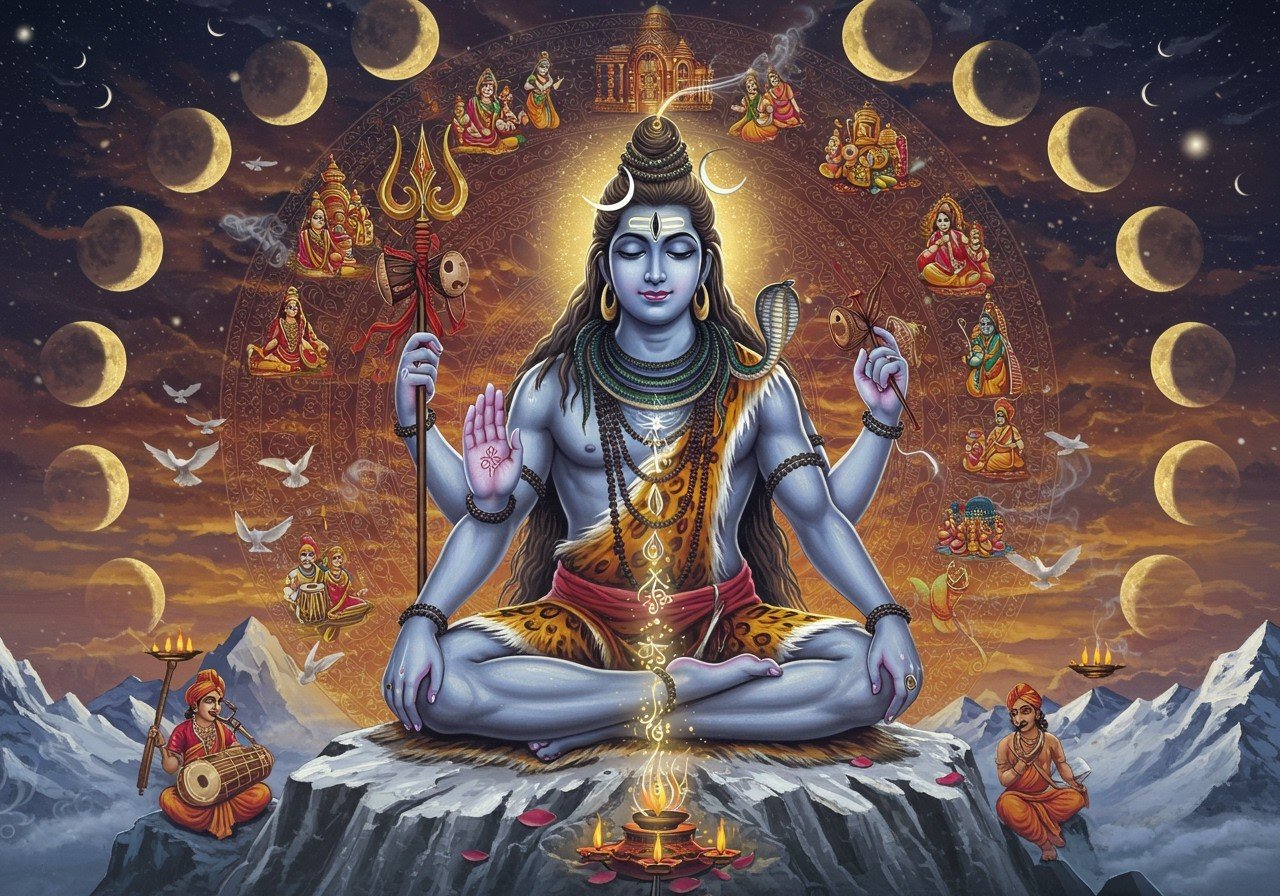
Rudrashtakam, also known as Shivashtakam, is a profoundly beautiful and powerful hymn dedicated to Lord Shiva. It holds a special place in Hindu rituals and personal prayers, offering a deep spiritual connection and facilitating meditation. Composed by the revered saint Goswami Tulsidas, this Sanskrit hymn, a part of the epic Ramcharitmanas, extols the divine attributes of Lord Shiva. Over time, the Rudrashtakam has been adapted into various musical forms, appealing to diverse audiences while maintaining its spiritual essence.
A Deeper Dive into Rudrashtakam
Rudrashtakam, a revered Sanskrit hymn, is a tribute to Lord Shiva. Originating from the Ramcharitmanas, penned by the saint Goswami Tulsidas, this hymn glorifies the virtues and powers of Lord Shiva, playing a significant role in Hindu rituals and traditions. It serves as a wellspring of devotion and a pathway to meditation for countless individuals. The adaptability of Rudrashtakam shines through in its diverse musical interpretations across genres, making it resonate with a broad spectrum of listeners. Various artists have lent their unique voices and styles to this hymn, each adding a personal touch to its timeless allure.
The true beauty of Rudrashtakam lies in its ability to forge a spiritual connection through the medium of music. Whether chanted traditionally or infused with contemporary elements, the hymn continues to inspire devotion and contemplation. By exploring its different renditions, one can truly appreciate the multifaceted ways in which Rudrashtakam resonates with devotees and music enthusiasts alike.
Delving into the Lyrics and Meaning
The Rudrashtakam, an eight-stanza hymn, masterfully encapsulates the divine attributes of Lord Shiva. Composed by the revered saint Goswami Tulsidas, it paints vivid imagery of Shiva’s cosmic role. Each stanza reverently praises different facets of Lord Shiva, such as his divine grace, his role in the cosmic cycle of destruction and renewal, and the ultimate liberation he offers. Tulsidas skillfully employs metaphors and similes, elevating the hymn beyond a mere spiritual ode to a literary masterpiece.
The lyrics illuminate Shiva’s compassion and boundless power, resonating profoundly with devotees. These profound verses often form the core of musical renditions, conveying spiritual messages that encourage introspection and devotion. In Hindu rituals, reciting or listening to the Rudrashtakam fosters a deep connection with the divine. Its cultural and religious significance makes it a treasured part of spiritual practices, passed down through generations.
Want to enhance your spiritual practice? Consider a Rudraksha mala, available at poojn.in. It’s a beautiful aid for chanting and meditation.
Traditional Renditions: Preserving the Essence
Renowned spiritual figures often offer traditional renditions of Rudrashtakam, emphasizing authenticity and preserving the hymn’s devotional core. Their vocal style, often accompanied by classical Indian instruments like the sitar and tabla, creates a serene and meditative atmosphere, ideal for connecting with the divine. These traditional interpretations are cherished by devotees seeking a pure and unadulterated spiritual experience.
Contemporary Interpretations: Bridging Tradition and Modernity
Many contemporary artists bring a modern sensibility to Rudrashtakam, blending classical elements with contemporary devotional music. This approach often incorporates instruments like the harmonium and flute, creating an accessible yet profound listening experience that resonates with a wider audience. These interpretations effectively bridge traditional devotion with modern musical sensibilities, making the hymn accessible to a broader range of listeners.
Looking for a serene atmosphere for your prayers? Incense sticks from poojn.in can enhance your spiritual experience.
Fusion and Innovation: Reimagining Rudrashtakam
Some musicians take an innovative approach, fusing traditional Sanskrit lyrics with genres like jazz or electronic music. This experimental approach often incorporates diverse instruments and soundscapes, appealing to younger audiences and those open to exploring new sonic territories. These innovative renditions showcase the remarkable adaptability of Rudrashtakam while preserving its cultural heritage.
Comparing Interpretations: A Spectrum of Devotion
The various interpretations of Rudrashtakam reveal a wide spectrum of devotional expression. Some artists maintain a strict adherence to tradition, while others bridge the gap between old and new, and yet others venture into innovative fusion territories. Each rendition caters to a different audience, reflecting the ongoing dialogue between preserving the sacred and embracing creative expression. This versatility ensures the enduring appeal of Rudrashtakam, allowing it to resonate with diverse listeners across generations.
The Enduring Power of Rudrashtakam
Rudrashtakam continues to captivate hearts and minds with its timeless beauty and spiritual depth. Through diverse musical renditions, it finds new expressions while honoring its sacred origins. Whether you connect with traditional purity, modern devotional styles, or innovative fusion, each version offers a unique pathway to connect with the divine. As you explore these renditions, you embrace a rich tapestry of devotion and culture, ensuring that the divine essence of Lord Shiva remains accessible to all who seek peace and spiritual connection. Its enduring charm lies in its power to seamlessly weave tradition with the evolving musical landscape.
For deeper understanding of these sacred symbols, read our blogs on Rudraksha and Tulsi and Yantras and Yagyas.
Frequently Asked Questions about Rudrashtakam
What is Rudrashtakam?
Rudrashtakam is a devotional hymn dedicated to Lord Shiva, composed by the saint Goswami Tulsidas as part of the Ramcharitmanas. It’s a powerful expression of reverence and devotion.
Why is it popular among different artists?
Its beautiful verses and deep spiritual meaning resonate with artists across various genres, inspiring diverse musical interpretations.
How do the renditions differ?
Each artist brings a unique style, ranging from traditional classical arrangements to modern devotional and fusion interpretations, creating a diverse soundscape.
What should I look for in different versions?
Pay attention to the musical arrangement, vocal style, and emotional expression. Each version offers a unique perspective on the hymn’s essence. Also, consider the specific instruments used and the overall atmosphere created.
Where can I find different interpretations?
Explore various music platforms, streaming services, and online resources dedicated to devotional music for a wide selection of Rudrashtakam renditions. You can often find specialized playlists or albums.
Why do artists choose to perform it?
Artists are drawn to its powerful spiritual significance and the opportunity to connect deeply with listeners through its timeless message. It’s a way to express devotion and share its beauty with others.
How do I choose which version to listen to?
Explore different styles to discover what resonates most with you – traditional, modern, or fusion. Your personal preferences and the specific context of your listening experience will guide your choice.
Can it be part of daily rituals?
Absolutely. Incorporating Rudrashtakam into your daily prayers or meditation can enhance your spiritual practice, fostering peace and connection with the divine. It can create a sacred atmosphere for your daily rituals.
Are there different versions of the Rudrashtakam?
While the core verses remain consistent, slight variations exist due to regional pronunciations, traditional nuances, and personal interpretations. The essence of the hymn, however, remains unchanged.
Enhance your puja experience with authentic items from poojn.in. We offer a wide selection of murtis, incense, and other puja essentials.


